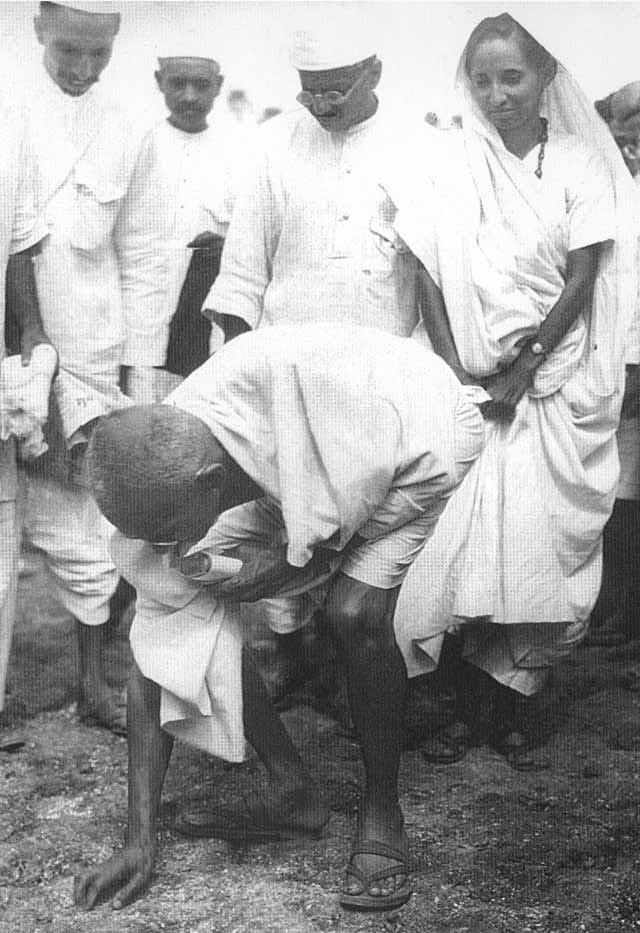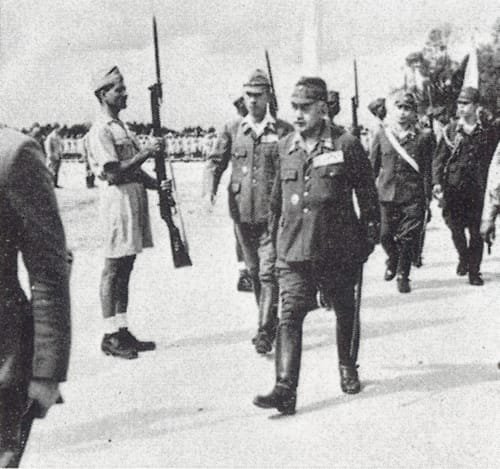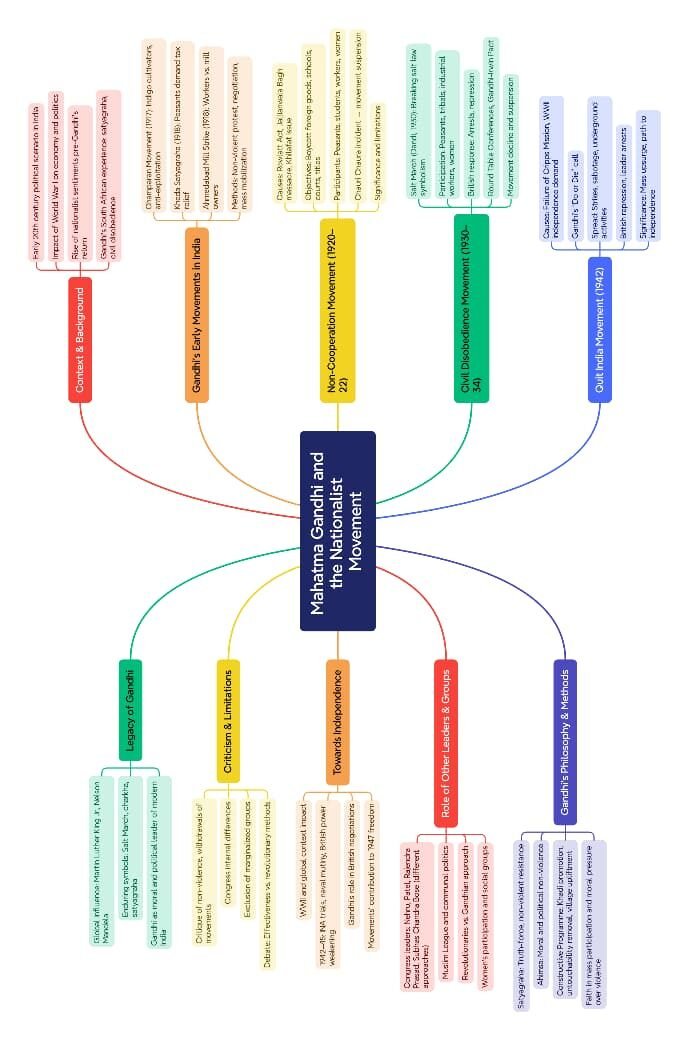Class 12 : History (English) – Lesson 11. Mahatma Gandhi and the Nationalist Movement
EXPLANATION & SUMMARY

Mahatma Gandhi making salt in Dandi (Gujarat).
📜✨ Explanation
🧭🌟 Context: Gandhi’s Emergence in Indian Politics
🔵 Gandhi returned from South Africa in 1915, bringing satyagraha (non-violent resistance) as a new method.
🟢 India, under harsh colonial economic and political control, needed a unifying strategy.
📜 His approach blended moral authority, mass mobilisation, and non-violent protest.
🌾📚 Early Experiments (1917–1918)
🏛️ Champaran Satyagraha (1917):
🌿 • Indigo peasants exploited by planters.
⚔️ • Gandhi investigated abuses and negotiated relief.
🏛️ Ahmedabad Mill Strike (1918):
🌾 • Workers demanded better wages.
💡 • Gandhi mediated—used hunger strike to pressure employers.
🏛️ Kheda Satyagraha (1918):
🌾 • Crop failure, yet revenue demanded.
📜 • Gandhi urged peasants to withhold taxes—government softened stance.
📜⚖️ Non-Cooperation Movement (1920–22)
🌾 • Sparked by Jallianwala Bagh massacre and Khilafat grievances.
🏛️ • Boycott of foreign cloth, schools, courts.
🗺️ • Widespread participation: students, peasants, artisans, merchants.
📚 • Chauri Chaura violence (1922) led Gandhi to suspend the movement—emphasising non-violence’s importance.
🧭📈 Civil Disobedience Movement (1930–34)
📜 Salt March (Dandi, 1930):
🌾 • Symbolised resistance to unjust salt laws.
🏛️ • Mass nationwide civil disobedience—salt-making, picketing liquor shops, boycotting British goods.
⚔️ • Gandhi arrested—movement energised masses.
📚 Round Table Conferences: Gandhi–Irwin Pact (1931) allowed him to attend negotiations in London.
🏛️🌿 Quit India Movement (1942)
🔵 Launched during WWII demanding immediate British withdrawal.
🟢 “Do or Die” call mobilised the nation despite arrests of leaders.
🗺️ Parallel governments formed in some regions.
📉 Suppression was harsh, but it showed Britain’s declining hold.
📚⚔️ Gandhi’s Mass Mobilisation Techniques
🌾 • Satyagraha: Non-violent protest grounded in moral force.
🏺 • Swadeshi: Promotion of local industry, boycott of British goods.
🧭 • Constructive Programme: Khadi-spinning, village uplift, Hindu-Muslim unity, untouchability eradication.
📜 • Negotiation + Protest: Balanced confrontation with dialogue.
🌾🏛️ Gandhi’s Ideals vs. Other Nationalists
📚 • Subhas Chandra Bose preferred militant action and foreign alliances.
🌾 • Revolutionaries pursued armed struggle.
🏛️ • Gandhi insisted on non-violence and inclusivity—believing means shaped ends.
🧭🌟 Representation in Sources
🏺 Official British Accounts: Depicted Gandhi as a moderate saint but distrusted mass mobilisation.
📜 Nationalist Writings: Portrayed him as Mahatma—moral guide and unifier.
🌾 Newspapers & Pamphlets: Spread his message across villages.
🗺️ Folk Songs/Oral Traditions: Celebrated salt satyagraha, Quit India heroes.
🏛️⚖️ Effects on Independence Struggle
📚 • Brought peasants, workers, women, and urban middle class into politics.
🌾 • Unified movements with moral clarity—international sympathy grew.
🏺 • Set tone for India’s democratic, non-violent political culture.
📜📉 Critiques and Limitations
🌾 • Some leaders felt Gandhi slowed momentum or compromised too easily.
📚 • Dalit leaders like B.R. Ambedkar criticised Gandhi’s handling of untouchability issues.
🏛️ • Partition tensions showed limits of his unifying message.
🧭🌿 Legacy
🔵 Gandhi’s strategies inspired global figures like Martin Luther King Jr. and Nelson Mandela.
🟢 His constructive programme—self-reliance, village industry, moral politics—remains influential.
📜 Non-violent resistance became a universal tool for justice movements.
🟡 Summary (~300 words)
🔶 Gandhi’s leadership reshaped Indian nationalism between 1915 and 1948. Early satyagrahas at Champaran, Ahmedabad, and Kheda demonstrated non-violent resistance’s power. The Non-Cooperation Movement (1920–22) mobilised millions but paused after Chauri Chaura violence. The Civil Disobedience Movement (1930–34), symbolised by the Salt March, expanded defiance nationwide, while the Quit India Movement (1942) pressed for immediate British exit.
🟢 Gandhi combined mass action with negotiation, promoting swadeshi, Hindu-Muslim unity, and social reform. He engaged peasants, workers, women, and the urban middle class, turning nationalism into a people’s movement.
🔴 British responses ranged from cautious negotiation (Gandhi–Irwin Pact) to brutal suppression (Jallianwala Bagh, Quit India arrests). Gandhi’s insistence on non-violence distinguished him from revolutionaries and militant leaders like Subhas Bose.
🟣 His methods faced criticism: some saw him as too conciliatory, while Ambedkar disagreed with his approach to caste reform. Partition and communal violence exposed challenges beyond his moral framework.
🧭 Despite limitations, Gandhi’s philosophy influenced global movements for justice, embedding non-violence and moral politics in India’s democratic ethos.
📝 Quick Recap
📜 Champaran, Ahmedabad, Kheda—early satyagraha successes.
🌾 Non-Cooperation (1920–22), Civil Disobedience (1930–34), Quit India (1942) shaped freedom struggle.
🏛️ Strategies: satyagraha, swadeshi, constructive programmes.
🧭 Negotiation balanced with protest—mass mobilisation of peasants, workers, women.
📚 Critiques: Ambedkar’s opposition on caste, Partition’s challenge to unity.
🌟 Legacy: Inspired global non-violent movements and anchored India’s democratic culture.

Indian National Army parade in Singapore 1944
————————————————————————————————————————————————————————————————————————————
QUESTIONS FROM TEXTBOOK
📜 Short Answer (100–150 words each)
📜 Q1. How did Gandhi try to connect with ordinary Indians?
🧭 Answer:
🌾 • Dressed in simple khadi and lived austerely to mirror villagers.
🏛️ • Travelled widely on third-class trains, visiting villages to understand struggles.
📚 • Spoke in local languages and used symbols like the charkha for self-reliance.
🗺️ • His humility bridged gaps between educated elites and rural masses.
📜 Q2. How did peasants view Gandhi?
🧭 Answer:
🌾 • Saw him as a Mahatma—protector of the poor.
🏛️ • Believed his blessings or presence could end injustices.
📚 • Linked him with divine power to resolve rent and revenue grievances.
📜 Q3. Why did salt laws become central to resistance?
🧭 Answer:
🌾 • Salt was essential for all, yet taxed heavily by the British.
🏛️ • Targeting salt united rich and poor in a common cause.
📚 • Gandhi’s Salt March symbolised defiance of unjust colonial control.
📜 Q4. Why are newspapers crucial for studying nationalism?
🧭 Answer:
🌾 • Carried nationalist speeches, debates, and protests to a wide audience.
🏛️ • Preserved multiple viewpoints—British, moderate, extremist.
📚 • Reveal how ideas spread among towns and villages, mobilising support.
📜 Q5. Why was the charkha chosen as a national symbol?
🧭 Answer:
🌾 • Represented swadeshi and economic self-reliance.
🏛️ • Evoked village industry and dignity of labour.
📚 • Became a unifying icon across classes and regions.
⚔️ Long Answer (250–300 words each)
📜 Q6. Explain how non-cooperation acted as a protest form.
🧭 Answer:
🌾 • Launched in 1920 after Jallianwala Bagh and Khilafat grievances.
🏛️ • Boycott of foreign cloth, schools, and law courts undermined colonial authority.
📚 • Peaceful picketing of liquor shops and promotion of khadi built self-reliance.
🗺️ • Refusal to pay taxes or serve British institutions forced recognition of Indian discontent.
🌾 • Chauri Chaura violence led Gandhi to suspend movement—highlighting commitment to non-violence.
📜 Q7. Why did Round Table Conference talks fail?
🧭 Answer:
🌾 • British unwilling to concede full self-government.
🏛️ • Deep communal and princely divisions weakened Indian unity.
📚 • Gandhi’s singular representation of Congress clashed with other interest groups.
🗺️ • Economic depression and British priorities elsewhere limited compromise.
📜 Q8. How did Gandhi reshape the national movement’s character?
🧭 Answer:
🌾 • Shifted nationalism from elite politics to mass participation.
🏛️ • Emphasised non-violence, satyagraha, and swadeshi—making struggle moral and inclusive.
📚 • Engaged peasants, workers, and women, turning nationalism into a people’s movement.
🗺️ • Balanced protest with negotiation, maintaining unity amid diversity.
📜 Q9. What do private letters and autobiographies reveal about individuals? How differ from official records?
🧭 Answer:
🌾 • Offer candid insights—emotions, doubts, motivations unseen in formal documents.
🏛️ • Gandhi’s letters show empathy and strategic thinking beyond public speeches.
📚 • Autobiographies provide reflective interpretation of events.
🗺️ • Unlike official records aimed at administration or propaganda, personal writings expose human dimensions and alternative perspectives.
————————————————————————————————————————————————————————————————————————————
OTHER IMPORTANT QUESTIONS FOR EXAMS
🏛️ SECTION A – MCQs (Q1–Q21)
📜 Q1. Gandhi first tested satyagraha in India at:
🔹 A. 📜 Champaran
🔸 B. 🏛️ Kheda
🔹 C. 🌾 Ahmedabad
🔸 D. 🗺️ Dandi
🧭 Answer: A
📜 Q2. The Khilafat movement was launched to support:
🔹 A. 🏺 Ottoman Caliphate
🔸 B. 📚 British reforms
🔹 C. 🌾 Indian Princes
🔸 D. 🗺️ European merchants
🧭 Answer: A
📜 Q3. Gandhi suspended Non-Cooperation after:
🔹 A. 🗺️ Chauri Chaura violence
🔸 B. 📜 Salt March
🔹 C. 🏛️ Jallianwala Bagh
🔸 D. 🌾 Quit India call
🧭 Answer: A
📜 Q4. The symbol of economic self-reliance was:
🔹 A. 📚 Telegraph
🔸 B. 🌾 Charkha
🔹 C. 🏛️ Railways
🔸 D. 🗺️ Zamindari
🧭 Answer: B
📜 Q5. Civil Disobedience began in 1930 with:
🔹 A. 🏺 Gandhi–Irwin Pact
🔸 B. 🌾 Dandi Salt March
🔹 C. 📜 Champaran Protest
🔸 D. 🗺️ Round Table Conference
🧭 Answer: B
📜 Q6. Quit India was launched during:
🔹 A. 📜 First World War
🔸 B. 🌾 Second World War
🔹 C. 🏛️ Boer War
🔸 D. 🗺️ Cold War
🧭 Answer: B
📜 Q7. The 1919 massacre that shocked India was at:
🔹 A. 🗺️ Kanpur
🔸 B. 📜 Jallianwala Bagh
🔹 C. 🏛️ Surat
🔸 D. 🌾 Bombay Docks
🧭 Answer: B
📜 Q8. Gandhi’s constructive programme included:
🔹 A. 📚 Military modernisation
🔸 B. 🌾 Khadi-spinning & village uplift
🔹 C. 🏛️ Import subsidies
🔸 D. 🗺️ Industrial tariffs
🧭 Answer: B
📜 Q9. The first Round Table Conference (1930) was boycotted by:
🔹 A. 🏺 Indian National Congress
🔸 B. 🌾 Princes
🔹 C. 📜 Muslim League
🔸 D. 🗺️ Liberals
🧭 Answer: A
📜 Q10. The Gandhi–Irwin Pact allowed:
🔹 A. 🌾 Immediate independence
🔸 B. 🏛️ Gandhi to attend Round Table Conference
🔹 C. 📜 Abolition of salt tax
🔸 D. 🗺️ Partition proposal
🧭 Answer: B
📜 Q11. Assertion–Reason
A: Gandhi emphasised non-violence.
R: He believed means shaped the moral quality of ends.
🔹 A. Both A & R true, R explains A
🔸 B. Both true, R doesn’t explain A
🔹 C. A true, R false
🔸 D. A false, R true
🧭 Answer: A
📜 Q12. Assertion–Reason
A: Salt was chosen for protest because it affected all Indians.
R: Taxing a basic necessity exposed colonial injustice.
🔹 A. Both A & R true, R explains A
🔸 B. Both true, R doesn’t explain A
🔹 C. A true, R false
🔸 D. A false, R true
🧭 Answer: A
📜 Q13. Match the event with its year:
(i) Champaran Satyagraha (ii) Non-Cooperation Launch (iii) Quit India (iv) Dandi March
🔹 A. (i 1917) (ii 1920) (iii 1942) (iv 1930)
🔸 B. (i 1916) (ii 1922) (iii 1930) (iv 1942)
🔹 C. (i 1918) (ii 1921) (iii 1935) (iv 1940)
🔸 D. (i 1920) (ii 1930) (iii 1942) (iv 1917)
🧭 Answer: A
📜 Q14. The weekly journal started by Gandhi in 1919 was:
🔹 A. 🗺️ The Leader
🔸 B. 📜 Young India
🔹 C. 🏛️ Indian Opinion
🔸 D. 🌾 Hind Swaraj
🧭 Answer: B
📜 Q15. Women’s participation rose notably during:
🔹 A. 📜 Champaran Satyagraha
🔸 B. 🌾 Civil Disobedience
🔹 C. 🏛️ Kheda Satyagraha
🔸 D. 🗺️ Bardoli movement
🧭 Answer: B
📜 Q16. British distrust deepened after:
🔹 A. 🌾 Gandhi’s fasts
🔸 B. 📜 Chauri Chaura incident
🔹 C. 🏛️ Round Table talks
🔸 D. 🗺️ Khilafat Conference
🧭 Answer: B
📜 Q17. The slogan “Do or Die” belongs to:
🔹 A. 📜 Non-Cooperation
🔸 B. 🌾 Quit India
🔹 C. 🏛️ Salt Satyagraha
🔸 D. 🗺️ Swadeshi movement
🧭 Answer: B
📜 Q18. Gandhi’s method of fasting aimed to:
🔹 A. 🏛️ Punish followers
🔸 B. 🌾 Apply moral pressure without violence
🔹 C. 📜 Gain weight
🔸 D. 🗺️ Secure British aid
🧭 Answer: B
📜 Q19. Identify the place of the historic salt march’s start:
🔹 A. 🌾 Sabarmati Ashram
🔸 B. 🗺️ Bardoli
🔹 C. 🏛️ Bombay
🔸 D. 📜 Poona
🧭 Answer: A
📜 Q20. The Gandhi–Ambedkar Poona Pact (1932) concerned:
🔹 A. 📜 Salt tax repeal
🔸 B. 🌾 Representation of depressed classes
🔹 C. 🏛️ End of Khilafat
🔸 D. 🗺️ Defence budgets
🧭 Answer: B
📜 Q21. Picture/ID: Identify the event symbolised by masses breaking salt law on beaches.
🔹 A. 🌾 Champaran Protest
🔸 B. 🗺️ Dandi March
🔹 C. 🏛️ Quit India rallies
🔸 D. 📜 Bardoli Satyagraha
🧭 Answer: B
🏺 SECTION B – Short Answer (Q22–Q25)
📜 Q22. Mention two features of Gandhi’s constructive programme and one of its aims.
🧭 Answer:
🌾 • Promoted khadi-spinning and village industries.
🏛️ • Encouraged Hindu-Muslim unity and uplift of “untouchables.”
📚 • Aim: Build moral self-reliant society to sustain swaraj.
📜 Q23. Give two reasons why Gandhi called off Non-Cooperation in 1922 and one effect of this decision.
🧭 Answer:
🌾 • Chauri Chaura violence violated non-violence principles.
🏛️ • Risk of escalating disorder threatened moral basis.
📚 • Effect: Movement paused, giving British temporary relief but preserving Gandhi’s ethical leadership.
📜 Q24A (choice). Explain two ways the Salt March broadened nationalist appeal.
🧭 Answer:
🌾 • Involved peasants, tribals, and women beyond urban elites.
🏛️ • Linked a basic necessity (salt) to colonial injustice, uniting diverse classes.
📜 Q24B (choice). State two outcomes of the Gandhi–Irwin Pact.
🧭 Answer:
🌾 • Political prisoners (non-violent) released.
🏛️ • Gandhi attended Second Round Table Conference, gaining negotiation space.
📜 Q25. List two reasons for launching Quit India and one immediate British response.
🧭 Answer:
🌾 • Britain’s wartime use of India without Indian consent.
🏛️ • Cripps Mission failure angered Congress.
📚 • Immediate arrests of Gandhi and Congress leaders to crush movement.
🏺 SECTION B (cont.) – Short Answer II
📜 Q26A (choice): List three reasons for launching the Quit India Movement in 1942.
🧭 Answer:
🌾 • Britain involved India in WWII without consultation.
🏛️ • Cripps Mission failed to guarantee real independence.
📚 • Growing impatience among masses and leaders for self-rule.
📜 Q26B (choice): State three British measures after Quit India to regain control.
🧭 Answer:
🌾 • Mass arrests of Congress leaders including Gandhi.
🏛️ • Censorship and curbs on press and gatherings.
📚 • Deployment of military and police to crush uprisings.
📜 Q27: Explain two ways women contributed to Gandhi’s movements and one impact.
🧭 Answer:
🌾 • Led picketing of liquor shops and foreign cloth.
🏛️ • Carried secret messages, sheltered activists.
📚 • Impact: Showed political agency of women, broadening nationalist base.
⚔️ SECTION C – Long Answer (300–350 words)
📜 Q28A (choice): Evaluate Gandhi’s role in transforming Indian nationalism into a mass movement.
🧭 Answer:
🌾 • Gandhi introduced satyagraha—non-violent moral force—to Indian politics.
🏛️ • Early campaigns—Champaran, Kheda, Ahmedabad—proved local grievances could be linked to national struggle.
📚 • Non-Cooperation (1920–22) mobilised peasants, students, traders; swadeshi and khadi became symbols of unity.
🗺️ • Civil Disobedience (1930–34), starting with Salt March, drew women, tribals, merchants, and workers.
⚔️ • Quit India (1942) demanded immediate independence; parallel governments emerged despite repression.
🌾 • Gandhi combined negotiation with protest (e.g., Gandhi–Irwin Pact) to keep movement inclusive.
🏛️ • His simplicity, spiritual authority, and constructive programme (khadi, village uplift, untouchability reform) bridged elites and masses.
📌 • Though criticised for compromises, his leadership gave nationalism a moral, mass-based character unmatched by others.
📜 Q28B (choice): Analyse the Gandhi–Irwin Pact and its significance.
🧭 Answer:
🌾 • Signed March 1931 between Gandhi and Viceroy Irwin after Salt Satyagraha.
🏛️ • Terms: Release of non-violent prisoners, right to make salt in coastal areas, withdrawal of civil disobedience, Gandhi to attend Round Table Conference.
📚 • Significance: Marked recognition of Congress as representative body; displayed Gandhi’s mix of firmness and pragmatism.
🗺️ • Critics felt concessions were minor, but the pact showcased negotiation as part of satyagraha strategy.
📜 Q29A (choice): Discuss the reasons behind suspending Non-Cooperation in 1922 and its consequences.
🧭 Answer:
🌾 • Chauri Chaura incident—police station burnt, 22 policemen killed—violated non-violence.
🏛️ • Gandhi feared descent into chaos and loss of moral high ground.
📚 • Suspension disappointed radicals, leading some toward revolution or Swaraj Party politics.
🗺️ • It preserved non-violence’s ethical foundation and Gandhi’s authority.
📜 Q29B (choice): Explain how salt became a powerful symbol during Civil Disobedience.
🧭 Answer:
🌾 • Salt essential for all—tax showed colonial intrusion into daily life.
🏛️ • Gandhi’s 240-mile Dandi March dramatized injustice.
📚 • Mass defiance—salt-making, boycotts, foreign cloth picketing—united diverse classes.
🗺️ • British arrests of leaders highlighted colonial fear of symbolic protest.
📜 Q30: Assess how newspapers and folk traditions shaped nationalist consciousness under Gandhi.
🧭 Answer:
🌾 • Vernacular papers spread speeches, protests, ideas beyond cities.
🏛️ • Provided debate space for moderates, radicals, and Gandhians alike.
📚 • Folk songs, plays, and ballads praised Salt March, Quit India heroes—reaching illiterate masses.
🗺️ • Together, print and oral traditions turned Gandhi’s campaigns into shared cultural memory.
🏛️ SECTION D – Source/Case-Based (1+1+2)
📜 Q31:
Source: “Gandhi’s fast is a moral weapon to awaken conscience.”
🧭 Answer:
🌾 (a) Highlights fasting as non-violent pressure.
🏛️ (b) Shows Gandhi’s belief in moral persuasion.
📚 (c) Demonstrates how symbolic acts mobilised public and unnerved rulers.
📜 Q32:
Source: “Do or Die—we shall either free India or perish.”
🧭 Answer:
🌾 (a) Slogan of Quit India Movement, 1942.
🏛️ (b) Expressed urgency and resolve against British rule.
📚 (c) Unified Indians across regions despite severe repression.
📜 Q33:
Source: “Khadi is the livery of freedom.”
🧭 Answer:
🌾 (a) Associates khadi with self-reliance and swadeshi.
🏛️ (b) Encouraged economic independence from British imports.
📚 (c) Became visual identity of nationalism under Gandhi.
🗺️ SECTION E – Map Work (5 marks)
📜 Q34.1: Mark Sabarmati Ashram on India map—Gandhi’s base before Salt March.
📜 Q34.2: Mark Dandi—site where Gandhi broke salt law.
📜 Q34.3: Mark Champaran (Bihar)—first satyagraha experiment in India.
📜 Q34.4: Identify two marked centres and state significance.
🧭 Answer:
🌾 • Dandi—symbol of mass civil disobedience via Salt March (1930).
🏛️ • Champaran—indigo farmers’ relief through satyagraha, launching Gandhi’s Indian leadership.
💬 VI Alternative: List three centres—Sabarmati, Dandi, Champaran—and explain significance of any two as above.
————————————————————————————————————————————————————————————————————————————
MIND MAPS

————————————————————————————————————————————————————————————————————————————
